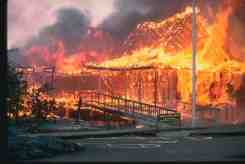 |
Fewer than one hundred people have been killed by eruptions in the recorded history
of Hawaii, and only one death has occurred in the 20th Century. However, the lava
flows are highly destructive to populated and cultivated areas. This set depicts the
negative impact of lava flows on communities, vegetation, marine life, roads, and
coastlines. It also illustrates the benefits of Hawaii volcanism such as the production
of geothermal power, increase in land area of the islands and other benefits. More
than 270,000 people have been killed directly or indirectly by volcanic activity worldwide
during the past 500 years. Nearly all of the deaths have been caused by explosive
eruptions of composite volcanoes along the boundaries of the Earth's tectonic plates.
Hawaii's volcanoes have more fluid, less gaseous magmas and produce quieter, less
hazardous eruptions. The village of Kapoho was entirely destroyed during the 1960
eruption in the lower east rift (fissure) zone of Kilauea. In the 1980s, flows from
Kilauea's east rift largely destroyed Royal Gardens and Kalapana. The March-April
1984 eruption of Mauna Loa threatened Hilo, with a population of about 40,000. Advancing
nearly 26 km in about 5 days, the active flows produced a bright red glow in the night
sky visible from Hilo. Much to the relief of the citizens, the flows stopped about
6.5 km short of the city's outskirts. These outskirts are built in part on the pahoehoelava
(smooth ropy lava) flows produced by the 1881 eruption of Mauna Loa, indicating that
Hilo is well within the reach of lava flows from the volcano. Although the destructive
effects of volcanism are more obvious, volcanoes also provide many benefits to mankind.
They are the major contributors to the building of continents, and all oceanic islands
owe their origin directly or indirectly to volcanism. Over the billions of years of
Earth's existence, water has been released from its interior by volcanoes and hot
springs near volcanic intrusions. Geothermal power produced by volcanism is an inexpensive
alternative energy source. The Hawaiian Islands were built over millions of years
by lava flows. The lava flows have provided the fertile soil in which crops such as
pineapples, sugar cane, and coffee thrive, and lush tropical vegetation flourishes.
The flows start to weather quickly in areas with adequate rainfall. In some cases
revegetation can begin in less than one year after the eruption. The lava flows are
very fertile, especially if they have been covered by ash. The fine ash particles
retain water within reach of plant roots and release plant foods such as potassium.
Vegetation that has been destroyed by ash falls returns in a more luxuriant form.
However in the island's arid areas, it may take thousands of years to form fertile
soils from erosion and breakdown of lava. Volcanic rocks provide an abundant local
source of materials for landscaping, construction, and road building. The majestic
mountains andbeautiful black sand beaches of Hawaii that draw thousands of tourists
each year are products of volcanism. Hawaii Volcanoes National Park provides one of
the few places in the world where visitors can safely view volcanic processes. The
Hawaiian volcanoes are contributing to the overall understanding of volcanoes; they
provide a natural laboratory for study of the eruptivephenomena. Careful research
and constant observation over long periods of time are important. From these data,
volcanologists are learning to interpret activity in order to advise local officials
of imminent eruptions. |